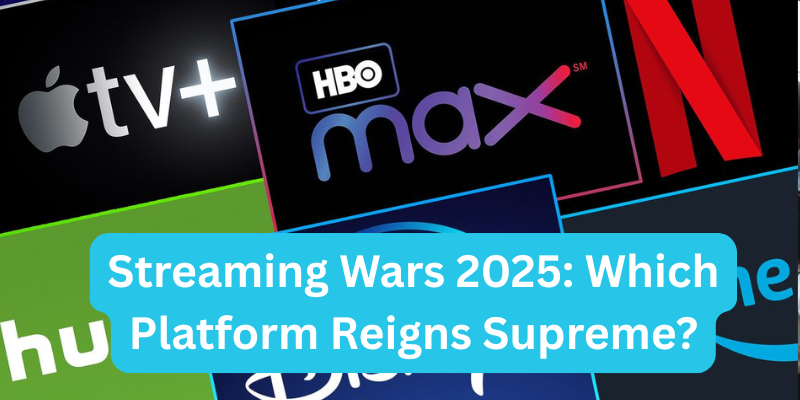The streaming landscape in 2025 is a fierce battleground, with platforms competing for subscribers through exclusive content, innovative features, and competitive pricing. As consumer preferences shift and subscription fatigue grows, the question looms: which streaming service stands above the rest? This article dives into the key players—Netflix, Disney+, Max, Prime Video, and others—evaluating their strengths, weaknesses, and unique offerings to determine which platform reigns supreme in 2025.
1. The State of the Streaming Wars in 2025
The streaming industry has evolved dramatically, with global subscription video on demand (SVOD) and ad-supported video on demand (AVOD) revenues projected to surpass $165 billion. However, the market is fragmented, with over 200 platforms vying for attention, leading to subscriber churn and consolidation efforts. Consumers crave seamless experiences, diverse content, and value for money, while platforms balance profitability with subscriber growth. In this crowded arena, only a few can claim dominance, driven by content quality, user experience, and strategic innovation.
2. Evaluating the Top Streaming Platforms
2.1 Netflix: The Content Powerhouse
Netflix remains the leader with over 300 million subscribers worldwide, bolstered by its vast library of originals like Stranger Things and Wednesday. Its focus on global content, niche genres, and sports-related programming, such as WWE’s Raw, keeps it ahead. Despite price hikes, with ad-supported plans at $8 monthly and standard ad-free at $18, Netflix’s algorithm-driven recommendations and weekly releases maintain its appeal. However, frequent show cancellations and a high cost can deter budget-conscious viewers.
2.2 Disney+: The Family Favorite
Disney+ has grown rapidly, leveraging its iconic franchises—Marvel, Star Wars, and Pixar—alongside Hulu and ESPN+ integration. Priced at $10 monthly for its ad-based plan or $16 for ad-free, it offers value through bundles, like the $11 Duo Basic with Hulu. New series like Star Wars: Skeleton Crew and family-friendly content keep subscribers engaged, but superhero fatigue and a shift toward general entertainment may challenge its niche dominance.
2.3 Max: Quality Over Quantity
Max, formerly HBO Max, is celebrated for its critically acclaimed originals, including The White Lotus and House of the Dragon, complemented by Discovery’s unscripted content. At $10 monthly with ads or $17 ad-free, it offers a robust library and live sports via its B/R tier. Its user-friendly interface and consistent releases make it a favorite, though a smaller catalog and an upcoming sports add-on cost increase could limit its appeal.
2.4 Prime Video: The Value Bundle
Prime Video, included with Amazon Prime at $14.99 monthly or standalone at $8.99, boasts big-budget originals like The Boys and a vast licensed content library. Its integration with shopping and offline viewing options adds value, but a cluttered interface and extra-cost content can frustrate users. Prime Video’s 230 million subscribers reflect its reach, yet it struggles to compete with Netflix’s content buzz.
2.5 Hulu: The Reliable All-Rounder
Hulu excels with next-day network show streaming and originals like The Bear, priced at $7.99 monthly with ads or $17.99 ad-free. Its strength lies in its Disney+ bundle synergy, but standalone pricing feels steep for its offerings. Hulu’s mix of TV and originals appeals to diverse audiences, though it lacks the cultural dominance of Netflix or Max.
2.6 Apple TV+: The Boutique Option
Apple TV+, at $9.99 monthly, focuses on high-quality originals like Severance and Ted Lasso, with a smaller but curated library. Its ad-free experience and cinematic production values attract discerning viewers, but limited content volume makes it a secondary choice for most. It’s ideal for those prioritizing quality over quantity.
2.7 Niche Players: Peacock and Paramount+
Peacock ($5.99 with ads, $11.99 ad-free) offers live sports, The Office, and affordable pricing, while Paramount+ ($5.99 with ads, $11.99 ad-free) delivers Star Trek and CBS content. Both cater to specific audiences but lack the broad appeal of top-tier platforms, making them supplementary rather than primary choices.
3. Emerging Trends Shaping the Streaming Wars
Consolidation is reshaping the industry, with bundling deals like Disney+, Hulu, and Max gaining traction to reduce churn and enhance value. Ad-supported tiers are rising, catering to cost-conscious viewers, while platforms experiment with live sports and interactive features to boost engagement. Traditional pay TV providers are pivoting to streaming hubs, offering bundles like Xfinity’s StreamSaver to integrate services. These trends signal a move toward simplified, flexible experiences that prioritize consumer choice.
4. Challenges in Crowning a Winner
No single platform dominates every aspect. Netflix leads in subscriber numbers and content volume, but its price hikes alienate some users. Disney+ excels for families, yet struggles with franchise fatigue. Max offers premium content but lacks scale, while Prime Video’s value is offset by a messy interface. Subscriber churn, driven by fragmentation and rising costs, pushes platforms to innovate or risk losing relevance. The winner depends on individual priorities—content variety, price, or user experience.
5. Conclusion: Choosing Your Streaming Champion
In 2025, no platform universally reigns supreme—each excels in distinct areas. Netflix dominates with content volume and global reach, Disney+ wins for families, Max leads in quality, and Prime Video offers unmatched value. Hulu, Apple TV+, and niche players like Peacock cater to specific needs. To choose, consider your priorities: Netflix for variety, Disney+ for kids, Max for prestige, or Prime Video for affordability. Test bundles or ad-supported plans to maximize value, and stay open to switching as platforms evolve.
6. Five Most Commonly Asked Questions About Streaming Platforms in 2025
Q1. Which streaming platform has the most subscribers?
Netflix leads with over 300 million subscribers globally, followed by Prime Video with approximately 230 million and Disney+ with rapid growth, though exact figures vary by region.
Q2. Is Netflix still worth its price in 2025?
Netflix’s $8 ad-supported or $18 ad-free plans are justified for viewers who value its originals and global content. However, budget-conscious users may prefer cheaper options like Peacock or bundled services.
Q3. What makes Disney+ stand out?
Disney+ shines with family-friendly content, Marvel and Star Wars franchises, and affordable bundles with Hulu and ESPN+. Its integration of live TV features and general entertainment broadens its appeal.
Q4. Can niche platforms like Peacock or Paramount+ compete?
Peacock and Paramount+ cater to specific audiences with sports, network shows, and franchises like Star Trek. They’re cost-effective but lack the universal draw of Netflix or Disney+.
Q5. How are streaming platforms addressing subscription fatigue?
Platforms are tackling fatigue through ad-supported tiers, bundling (e.g., Disney+, Hulu, Max), and unified interfaces to simplify access. Consolidation and flexible pricing aim to retain subscribers.




